The threat of winter weather pushed right up to the last frost date for my area this year. Add in my hectic schedule the past few weeks and the result is a late start on my spring garden, and some corners looking to be cut.These colorful lettuce varieties would normally be carefully planned and planted in their own distinct areas.This year I am deploying what I am calling a laissez-faire farming method of "mixed lettuces" saving a lot of time and proving that even lackadaisical farming sounds better in french.Seeding and watering these 9 square feet (around 100 plants) was the work of 5 minutes.I have to give a quick shout out to the oregano photo bombing the picture above (bottom and right of garden bed). This now feral oregano self seeded the area around it two years ago when I had the herb planted in this box. It is so thick and lovely year round that I am tempted to use it as a ground cover along paths.For the rest of my garden, this year I am doing a lot more grouping than normal, with all of a bed planted with spinach or radishes or edamame, allowing me to broadcast seeds and get everything started a little faster.Au revoir!
Read MoreGetting More From Morels
In mid-April I had to concede defeat in my attempt to grow morel mushrooms and turned my attention to procuring dried morels instead. After a lot of price shopping I decided to try LifeGourmetShop.com and while I waited for my package to arrive, I started researching how to use dehydrated morels in place of fresh ones.The available information on rehydrating morels is generally straightforward with a few notable exceptions. Mushrooms should be placed in a liquid for around 20 minutes. What type of liquid is at the discretion of the chef, but most agree that water is just fine. Some people recommend hot water while other say that hot water will pull more of the morel flavor from the mushroom to the water.Taking the more conservative approach, I have used cold water with great effect and based on the heavy morel perfume and coloring of the cold water after a 20 minute soak, I think cold is the best approach. For the past month I have been enjoying morels that look, feel and taste *almost* like fresh morels in everything from omelets and pasta sauce to mixing them in with ground beef for hamburgers and stir fries. But what to do about all that mushroomy goodness left in the water they were soaked in?Luckily, one of the sites I searched had a great tip - filter the morel water and use it as a partial or whole replacement for water or stock in recipes that would be complimented with a bit of umami.A paper towel tucked over the opening of a container makes a great strainer to remove any grit or debris that may have been tucked into the folds of the morel for fresh uses (next 2 days). Strain and pour into ice cube trays, then pop out the cubes and place in a freezer safe bag for a longer shelf life.Since learning this trick I have been using the golden liquor to replace potions of chicken, beef and vegetable stock as well as added to water for boiling pasta. It's a great way to stretch my borrowed harvest for this year into many more dishes and over a longer period.My 6th grade Home Ec teacher would be proud!
Read MoreGreen Mulching
While looking for a readily available, organic mulch to compliment my semi-composted pine needles, I have learned that the list of mulching styles and materials is truly endless. The list of possibilities include but is not limited to: sheet mulching, lasagna mulching (which does not actually involve pasta), plastic mulching, deep mulching, green manure mulching (which is green, but not manure), straw mulching...as I said, endless.The option I found most interesting is green mulching, using plant matter that would otherwise go into the compost bins, instead applied directly on the soil as a biodegradable mulch, effectively cutting out the middleman.I have begun this process primarily with weeds in my yard and the few volunteer plants that come up in my garden. This week the main contributor has been the Yellow Woodsorrel that has popped up in clumps all around my yard.Yellow Woodsorrel, so called for the small, yellow flowers it produces, is an edible forage green that is commonly called 'false clover' in the midwest. It has appeared this year in such abundance that I can both have my cake and eat it too by using it as a primary green mulch. Below is the result of just a few minutes worth of pulling sorrel and mulching between asparagus crowns.For my foraging friends, the other edible forage plant I have in abundance this year is Common Chickweed. It has been blooming for months so I use it as a wild edible, but not as mulch to avoid introducing new seeds into the garden.The trick with using any plant you find in your yard (weed, grass or otherwise) as green mulch is to make sure you do not include the flowers or seeds. Even when the flowers seem small and closed it is better to pluck them off before tossing them between plantings."Earth knows no desolation. She smells regeneration in the moist breath of decay." ~ George Meredith
Read MoreMaking Lemonade
Unless I take the time to carefully pluck them out, one by one, before taking a garden pic, you have probably noticed the indecent number of pine needles lurking in the background of EVERY PHOTO I TAKE!Once upon a time I had big dreams of chicken wire leaf bins in my backyard to effortlessly convert the sweet gumball and maple leaves raked up each fall into garden gold over the course of a year. In these fantasies I would empty the bins the following fall and add the compost to my garden before starting the cycle over again.Instead, the home I purchased has pine trees. Loblolly Pine trees (Pinus taeda) to be exact and the leaves they shed do not turn into lovely compost over the course of a year but instead, remain defiantly pine needle-like for much, much longer.After a bit of debate and confirming that pine needles making soil acidic is actually an old wives tale, I decided to compost them anyway (note: this was my idea, not the pine needles').Then, magically, after two years of composting, I have...pine needles!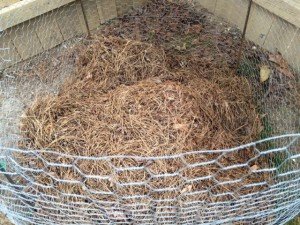 Pine needles don't turn into compost very quickly, but one of my goals this year is to mulch and I have been casting around for a sustainable, organic mulch that would work well in my garden beds. After two years of composting, I did get somewhat broken down needles that would work very well as a mulch.
Pine needles don't turn into compost very quickly, but one of my goals this year is to mulch and I have been casting around for a sustainable, organic mulch that would work well in my garden beds. After two years of composting, I did get somewhat broken down needles that would work very well as a mulch.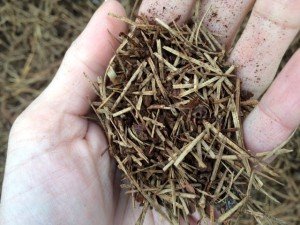 I started mulching around my transplanted collards while I wait for my direct sown spinach and sugar snap peas to fully sprout and I have to admit the result is quite nice.
I started mulching around my transplanted collards while I wait for my direct sown spinach and sugar snap peas to fully sprout and I have to admit the result is quite nice.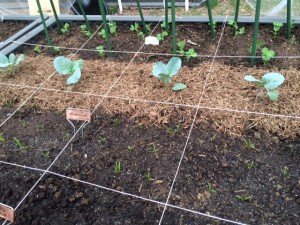 Because I have been turning the needles in their bin throughout the year, I know they hold moisture and attract earthworms so should work well as a mulch.
Because I have been turning the needles in their bin throughout the year, I know they hold moisture and attract earthworms so should work well as a mulch.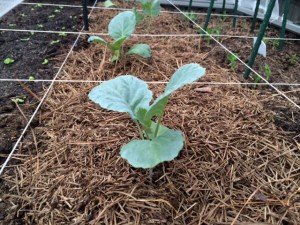 Okay, that was a completely gratuitous pic just because they looked so pretty.So now, I have made lemonade from my lemons and looking over my garden plan now I find myself in the position I could not have conceived of a year ago, I am not sure I have enough pine needles!
Okay, that was a completely gratuitous pic just because they looked so pretty.So now, I have made lemonade from my lemons and looking over my garden plan now I find myself in the position I could not have conceived of a year ago, I am not sure I have enough pine needles!
Paradigm Shift
I sometimes forget the prevailing notions people have related to growing food. The most common mental images seem to center around long hours of back breaking labor spent tilling, planting, hoeing and weeding.I am quickly reminded of the current thinking when I breezily say things like, "I planted 288 spinach plants today and need to do the same for lettuce tomorrow." and the person I am speaking with gapes in horror at the perceived amount of time and effort that goes into it. But the chasm between what they are thinking and what I actually did is as big as the Grand Canyon. We are operating under two VERY different paradigms when it comes to growing food...Depending on the agricultural model used, growing food can be relatively low-labor and the little time and money spent in the garden is subtracted directly from the time and money that would otherwise be spent driving to the grocery store, finding produce that is less nutritious and fresh, waiting in the checkout line to pay and then driving home on a daily or weekly basis.This morning I planted 36 Red Romaine lettuces and the whole process took about 20 minutes. I started with a homemade plant spacing tool made from plywood, cheap cabinet handles and recycled wine corks: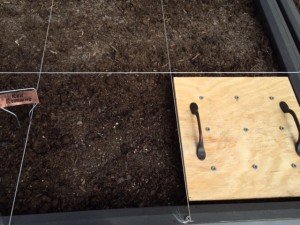
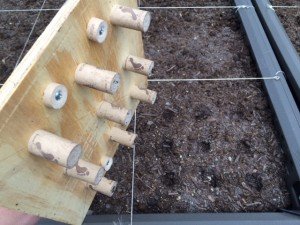 Lettuce can be planted 9 to a square foot so I pressed the spacer into 4 of my 1'x1' squares to leave divots where the seeds should be planted.Next I shook out some seed into my palm and placed 2 per divot. I normally have really good germination rates with the Baker Creek lettuce seeds, but these are last year's seeds so I did 2 to be safe. This was the most time intensive part of the whole operation but not what I would call laborious.
Lettuce can be planted 9 to a square foot so I pressed the spacer into 4 of my 1'x1' squares to leave divots where the seeds should be planted.Next I shook out some seed into my palm and placed 2 per divot. I normally have really good germination rates with the Baker Creek lettuce seeds, but these are last year's seeds so I did 2 to be safe. This was the most time intensive part of the whole operation but not what I would call laborious. When I was done I patted the soil over the seeds, lightly covering them and creating good dirt to seed contact then watered.
When I was done I patted the soil over the seeds, lightly covering them and creating good dirt to seed contact then watered.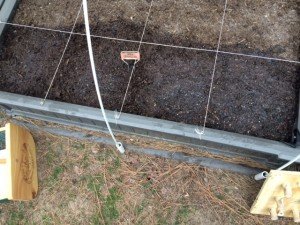 Voila!Yes there will be some watering throughout the season and yes, I do get an occasional volunteer plant that needs to be plucked out of my garden beds, but those are minor things, easily taken care of when I head out to my backyard grocery store each night and look around to see what's for dinner.
Voila!Yes there will be some watering throughout the season and yes, I do get an occasional volunteer plant that needs to be plucked out of my garden beds, but those are minor things, easily taken care of when I head out to my backyard grocery store each night and look around to see what's for dinner.
Don't Blink
During the past week of business travel my indoor plant starts have grown with the vigor of youth into a verdant and slightly unruly bunch of tweens. The tomatoes from my saved seed are particularly in need of thinning. I seeded them a little more thickly since I did not know what my germination rate would be. While they initially lagged about week behind fermented seeds I purchased this year, the germination rate for my saved seed looks to be close to 100%.
The tomatoes from my saved seed are particularly in need of thinning. I seeded them a little more thickly since I did not know what my germination rate would be. While they initially lagged about week behind fermented seeds I purchased this year, the germination rate for my saved seed looks to be close to 100%. Pro Tip - always use scissors to snip off the plants you are thinning to avoid disturbing the roots of chosen specimen.
Pro Tip - always use scissors to snip off the plants you are thinning to avoid disturbing the roots of chosen specimen.
Tender Beginnings
While winter is having it's (hopefully) last hurrah outside, I am prepping my indoor garden to be without me for a week while I travel for work.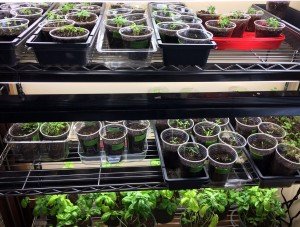 After trying first newspaper pots then peat pots for last year's starts and having them disintegrate before I was ready to transplant to the garden, this year I am using Siloé Oliveira's technique of drilling holes in smooth plastic cups that can be reused year after year.All of my starts are doing well but the ones I am happiest about are my saved seed from the Paste and Amana tomatoes I grew last year. They sprouted a few days behind the new varieties I purchased seed for this year, but since I did not ferment the saved seed I knew they would lag a bit.
After trying first newspaper pots then peat pots for last year's starts and having them disintegrate before I was ready to transplant to the garden, this year I am using Siloé Oliveira's technique of drilling holes in smooth plastic cups that can be reused year after year.All of my starts are doing well but the ones I am happiest about are my saved seed from the Paste and Amana tomatoes I grew last year. They sprouted a few days behind the new varieties I purchased seed for this year, but since I did not ferment the saved seed I knew they would lag a bit.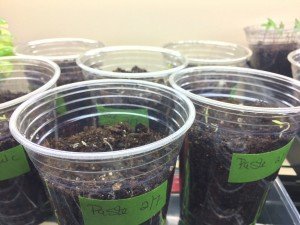 And gratuitous pics of some of the collards and other tomato varieties starts just because they are so pretty...
And gratuitous pics of some of the collards and other tomato varieties starts just because they are so pretty...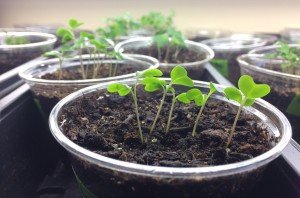
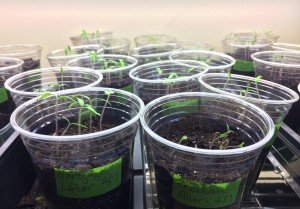
Starting My Garden Early
While Punxsutawney Phil and the meteorologists work out their differing predictions for the end of winter, growers are already hard at work preparing for spring, summer and fall.January plant starts included cabbage,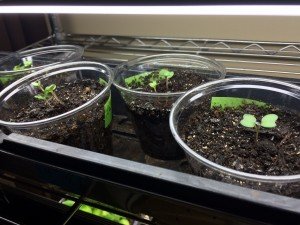 chili peppers, bell peppers and rosemary.
chili peppers, bell peppers and rosemary.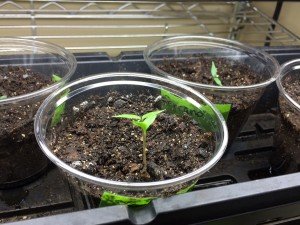 Now that February has begun, the seed starting kicks into high gear with oregano, collards and lots and lots of tomatoes with 8 varieties and a total of 38 plants this year!
Now that February has begun, the seed starting kicks into high gear with oregano, collards and lots and lots of tomatoes with 8 varieties and a total of 38 plants this year!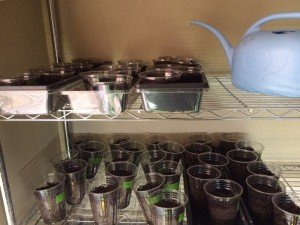 The new starts will welcome roommates in my growing nook for the cilantro and basil I grow indoors each winter. I purchased inexpensive shop lights, metal wire shelving units and florescent tubes 5 years ago so I never have to go a grey winter day without their bright colors and fresh flavors complimenting meals.
The new starts will welcome roommates in my growing nook for the cilantro and basil I grow indoors each winter. I purchased inexpensive shop lights, metal wire shelving units and florescent tubes 5 years ago so I never have to go a grey winter day without their bright colors and fresh flavors complimenting meals.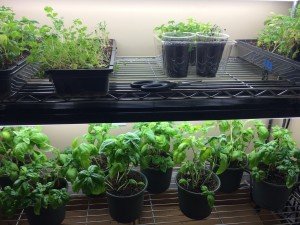 The minimal, initial investment for the equipment has more than paid for itself already and now as my garden diversifies and the number of indoor starts continue to expand each year with no additional infrastructure costs to date, I consider this money extremely well spent.Happy Spring, whenever it comes :)
The minimal, initial investment for the equipment has more than paid for itself already and now as my garden diversifies and the number of indoor starts continue to expand each year with no additional infrastructure costs to date, I consider this money extremely well spent.Happy Spring, whenever it comes :)
Hello, My Name Is...
This year will be my fifth year as an urban food grower. It will also be my fifth attempt to create plant markers that are still legible at the end of a growing season. With 52 varieties of annuals planned in addition to the handful of perennials that live in my garden, knowing who is who can be important. This is particularly true when it comes to saving seed.In previous years I have tried cheap plastic tags labeled with sharpee, which faded after just a few short months followed by the same plastic tags using pencil after reading the graphite would weather better than ink. They did not fade quite as much or as fast as the sharpee had, but were still hard to read after a few months of sun and rain. Next up was wine corks with sharpee thinking that the porous nature of the corks would absorb the ink better than the hard plastic had but which also faded into illegibility by mid season.For this year's garden I was determined to find something more lasting and attractive for my plant markers since the majority of these varieties will be planted year after year. I spent some time researching permanent plant markers and found these copper plate markers that can be inscribed with a pen and a bit of elbow grease.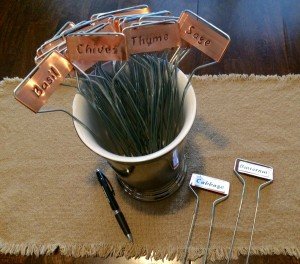 The initial cost to purchase and the time to label are certainly higher than my previous marker attempts but the end result is much more pleasing and should endure for many years to come.To inscribe the markers I printed out my varieties list in a nice, easily readable font. I laid the variety name printout over the copper plate and gently traced out the letters. I then removed the printout and used the pen to go over the letters directly on the copper plate until satisfied with the depth and thickness of the letters.
The initial cost to purchase and the time to label are certainly higher than my previous marker attempts but the end result is much more pleasing and should endure for many years to come.To inscribe the markers I printed out my varieties list in a nice, easily readable font. I laid the variety name printout over the copper plate and gently traced out the letters. I then removed the printout and used the pen to go over the letters directly on the copper plate until satisfied with the depth and thickness of the letters.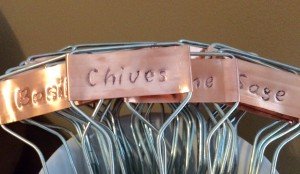 Each year my garden gets better and better #kaizen
Each year my garden gets better and better #kaizen
The Expat Starter Garden
A dear friend is moving south of the border to live on the shores of Lake Chapala, said to have the second best climate on earth, behind only Atenas, Costa Rica. She wants to start a small garden there and was looking for suggestions.All of these suggestions do very well in both containers (both patio and raised bed) and in rich garden soil, making them versatile, low maintenance choices for a first time gardener.If you are only going to grow one thing, I think basil is a great place to start. It is easy to grow, abundantly productive and can be added to almost every meal you make or have for takeout. I prefer the sweet genovese varieties.If you are only going to grow two things, then basil and cilantro are my choices. Again, easy, abundant and can add a bright taste to any dish, homemade or otherwise. For warmer climates (mine included) try a slo bolt variety.Oregano and rosemary are also low maintenance but useful and abundant herbs for a first time gardener and experienced cook.If she wants to expand beyond herbs, spinach is a great choice for novices. Leaves can be taken as needed allowing the plant to continue growing, many fresh or cooked uses and easy to grow. Again, with warmer climates, a slo bolt variety would be best.After spinach, the chili pepper of your preferred spiciness range. I favor serranos. They are very abundant producers, impart a great flavor in addition to the heat they add to dishes and can be picked green or red depending on your heat preferences. Roasting ripe ones each time you grill and freezing them means delicious roasted peppers on hand year round.And then every gardener's pride and joy, tomatoes. For many of the same reasons, I would recommend cherry type tomatoes for the small scale gardener. They produce much more abundantly than slicing tomato varieties and due to their size can be dried or roasted and frozen for year round additions to meals.With just these 7 items, incorporating bounty fresh from the garden (or preserved from the garden) year round is easy and will work into everyone's favorite dishes.
Regrowing Update
An update from last month's post on regrowing veggies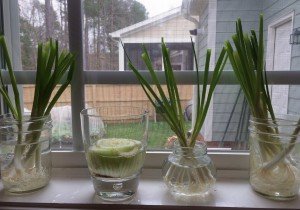 I have tripled the number of green onions I am regrowing to keep up with culinary demands and have just started my first celery, another in demand veggie that I will need to add more of with another purchase or two.
I have tripled the number of green onions I am regrowing to keep up with culinary demands and have just started my first celery, another in demand veggie that I will need to add more of with another purchase or two.
Countdown to Garden 2016
Even before presents are unwrapped, the countdown is on with less than a month to go before indoor starts of cabbage, leeks and rosemary get going in the first part of January with peppers (hot and bell) just behind.So I've been making my list and checking it twice this week to see what varieties will make it into my 219 square foot of garden space for 2016.I am making heavy use of containers for herbs (and one lettuce I just couldn't resist) and also using two composted trenches in the yard to grow The Three Sisters: corn, blackeyed peas and decorative squash. I currently have 8 1x1 boxes for cucurbits, but will be adding in 3 more before spring to hold all the zucchini, squash and cucumbers on my list.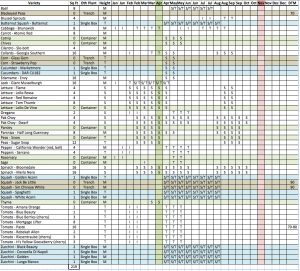 Despite planning 52 different varieties of annuals for next year, my 2016 seed order (including shipping) came in under $42. This economy was mostly due to saving more of my own seed this year than ever before and having plenty of unused 2015 seed for most of what I plan to grow next year - Square Foot Gardening makes better use of individual seeds than row gardening so more seeds are conserved for future use.
Despite planning 52 different varieties of annuals for next year, my 2016 seed order (including shipping) came in under $42. This economy was mostly due to saving more of my own seed this year than ever before and having plenty of unused 2015 seed for most of what I plan to grow next year - Square Foot Gardening makes better use of individual seeds than row gardening so more seeds are conserved for future use.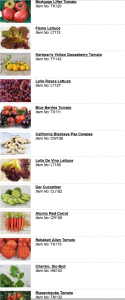 One of my splurge purchases for this year was the Slo-Bolt Cilantro. I am still drawing down the huge supply of cilantro/coriander seeds saved from my 2012 garden. They still have a high germination rate so I have been using them for both outdoor garden and microgreen plantings since then. If the slo-bolt lives up to its name, my 2012 cilantro has had its last reproductive cycle and will be only for microgreens and I will switch to saving the slo-bolt seed.Next I will start plotting out the placement of these plantings on my garden map. 2015 was my first full garden cycle in Raleigh and the biggest lesson was that maximizing light has to be a priority for north facing gardens further complicated by some tree shade. To that end, I added a height column with each plant ranked Short, Medium or Tall to plan my garden for next year. Tallest plants in to the north and shortest plants to the south has always been the rule of thumb but is now a requirement for my future garden plans which will make crop rotations a little more challenging.It is damp, but in the low-mid 70's this weekend, so I will also spend some time putting in new grids into my raised beds. I have been using kitchen string for the past few years but the cottony string only lasts one year before stretching, breaking and needing to be replaced. This year I am going to try a white nylon string that is made for outdoor use and hope it holds up better.Here's to a wonderful close to 2015 and a bright start to 2016! Happy Holidays!
One of my splurge purchases for this year was the Slo-Bolt Cilantro. I am still drawing down the huge supply of cilantro/coriander seeds saved from my 2012 garden. They still have a high germination rate so I have been using them for both outdoor garden and microgreen plantings since then. If the slo-bolt lives up to its name, my 2012 cilantro has had its last reproductive cycle and will be only for microgreens and I will switch to saving the slo-bolt seed.Next I will start plotting out the placement of these plantings on my garden map. 2015 was my first full garden cycle in Raleigh and the biggest lesson was that maximizing light has to be a priority for north facing gardens further complicated by some tree shade. To that end, I added a height column with each plant ranked Short, Medium or Tall to plan my garden for next year. Tallest plants in to the north and shortest plants to the south has always been the rule of thumb but is now a requirement for my future garden plans which will make crop rotations a little more challenging.It is damp, but in the low-mid 70's this weekend, so I will also spend some time putting in new grids into my raised beds. I have been using kitchen string for the past few years but the cottony string only lasts one year before stretching, breaking and needing to be replaced. This year I am going to try a white nylon string that is made for outdoor use and hope it holds up better.Here's to a wonderful close to 2015 and a bright start to 2016! Happy Holidays!
Winter Growing
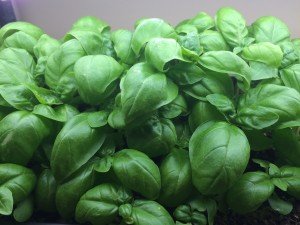 This winter there will be a lot of focus on my indoor gardens mostly because my outdoor winter garden is a bit of a bust this year. The collards and spinach I planted were just beginning to grow when an unseasonable cold-snap halted them in their tracks. I tried resowing but still don't have much of anything green going on outside. I haven't given up completely on the 3 inch tall collards that I still hope will be served on New Years, but accept that I may be buying most of my good luck meal this year instead of growing it.Right now my indoor garden consists of two trays of basil microgreens (already harvesting from the tray on the left) and 8 pots of basil that will be allowed to grow into full plants of about 8" tall and pruned a bit daily as needed for meals.
This winter there will be a lot of focus on my indoor gardens mostly because my outdoor winter garden is a bit of a bust this year. The collards and spinach I planted were just beginning to grow when an unseasonable cold-snap halted them in their tracks. I tried resowing but still don't have much of anything green going on outside. I haven't given up completely on the 3 inch tall collards that I still hope will be served on New Years, but accept that I may be buying most of my good luck meal this year instead of growing it.Right now my indoor garden consists of two trays of basil microgreens (already harvesting from the tray on the left) and 8 pots of basil that will be allowed to grow into full plants of about 8" tall and pruned a bit daily as needed for meals.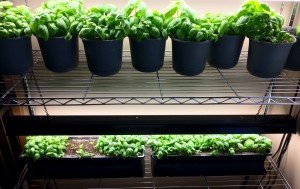 I will be starting another 3 trays of cilantro microgreens this weekend and will do various other types of microgreens (arugula, mustard and red cabbage) off and on all winter to add some homegrown flavor and crunch to winter meals.If you are considering indoor growing, microgreens have a lot going for them. They have a very quick turn around, usually only 2-4 weeks from beginning to end which is basically instant gratification in the gardening world. And due to their fast germination to harvest cycle, they aren't usually around long enough for pests and diseases to become an issue.These little plants really do have some powerful flavor, often even more than their adult versions and growing research from reputable sources is showing that some of them are packed with up to 5x the vitamins and carotenoids found in the adult versions of the same plants.So whether or not my outdoor garden takes off with this wonderfully sunny and warm week we are having, I will be posting (and eating) fresh all winter long.
I will be starting another 3 trays of cilantro microgreens this weekend and will do various other types of microgreens (arugula, mustard and red cabbage) off and on all winter to add some homegrown flavor and crunch to winter meals.If you are considering indoor growing, microgreens have a lot going for them. They have a very quick turn around, usually only 2-4 weeks from beginning to end which is basically instant gratification in the gardening world. And due to their fast germination to harvest cycle, they aren't usually around long enough for pests and diseases to become an issue.These little plants really do have some powerful flavor, often even more than their adult versions and growing research from reputable sources is showing that some of them are packed with up to 5x the vitamins and carotenoids found in the adult versions of the same plants.So whether or not my outdoor garden takes off with this wonderfully sunny and warm week we are having, I will be posting (and eating) fresh all winter long.
Store Bought Reboot - Regrowing Veggies
Here at NearlyHomeGrown, food scraps usually end up being frozen for future vegetable and/or chicken stocks or composted to feed the next generation of growing food. But I have been interested in the regrowing veggies craze and finally had the perfect reason to try it.The latest shiitake flush resulted in 7.7 oz of fresh mushrooms and they have been going into almost every meal in one way or another, but especially into homemade ramen noodle soup where they are a headliner ingredient. One of the other ingredients, the scallions, have been something of a philosophical splurge for this autumnal meal. They are store bought, out-of-season produce that I could live without but really didn't want to because of the flavor and color they add to the dish...and voila! The perfect vegetable to try regrowing!
One of the other ingredients, the scallions, have been something of a philosophical splurge for this autumnal meal. They are store bought, out-of-season produce that I could live without but really didn't want to because of the flavor and color they add to the dish...and voila! The perfect vegetable to try regrowing!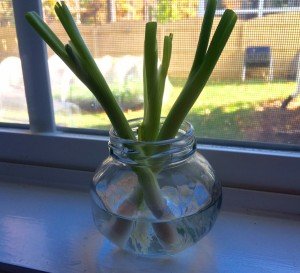 The green onion ends were pulled from the cooking scrap pile destined for stock making and put into a clear jar with fresh water and placed in a sunny window. The water will need to be changed every other day between now and spring when I will try planting them in my outdoor garden. In the meantime I can continue to steal the green tops for ramen soup and other dishes while keeping the root alive and growing.
The green onion ends were pulled from the cooking scrap pile destined for stock making and put into a clear jar with fresh water and placed in a sunny window. The water will need to be changed every other day between now and spring when I will try planting them in my outdoor garden. In the meantime I can continue to steal the green tops for ramen soup and other dishes while keeping the root alive and growing.
Growing Sustainability - Part 2
In Growing Sustainability - Part 1 I lauded the War Commission Gardens and Victory Gardens for what they grew, a lot of food and a more self-sufficient citizenry. At their height, over 20,000,000 Victory Gardens dotted the American landscape and in 1944, they were producing 40% of all the vegetables grown in the US. These small scale but widespread gardens and orchards contributed to the food landscape in many subtle ways beyond just the food produced on them. A diversity of growers and a diversity of what is grown seems to go hand-in-hand.This startling illustration by the Rural Advancement Foundation International-USA depicts the realities of our dwindling agricultural biodiversity with a sampling of the commercially available varieties of 10 commonly grown vegetable seeds from seed houses in 1903 at the top of the chart and the dramatic reduction in varieties of those same vegetables at the National Center for Genetic Resources Preservation just 80 years later.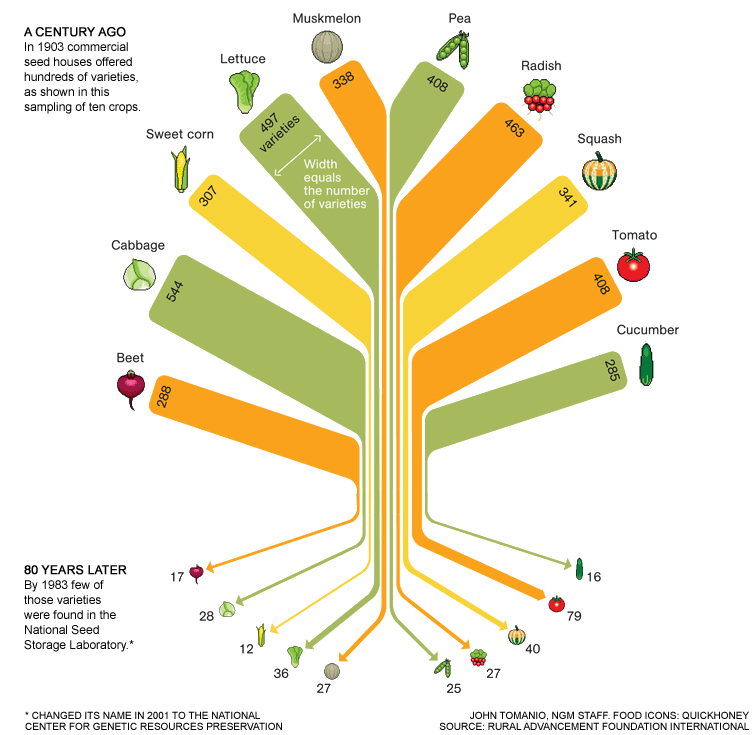 And it is not just the 1o varieties shown above that are at risk - this article by National Geographic puts the estimated diversity loss of all historic fruits and vegetables for the US at 90% while this Food and Agriculture Organization of the United Nations article puts the total global decrease of plant diversity at 75% in the last century.But there is good news in the What's For Dinner in 2025 discussion as well. Recessions spur backyard growing in a big way because growing your own food is cheaper than buying it. And this last recession happened in the age of the internet! How to plant, grow and harvest videos populate YouTube and sites like Garden Girl TV. Online seed houses for heirloom and open pollinated seeds have exploded in number and serve to connect the growers to a growing variety of available seeds. Two of my favorites are Baker Creek Heirloom Seeds and Seed Savers Exchange. Countless rural and urban farmers have blogs and vlogs, sharing their successes and failures and creating online communities that are (excuse the pun) growing.Whether the online/rural/suburban/urban agricultural movement of people growing food where ever they live will be able to sustain itself over the long haul is anyone's guess. So a further bit of good news for future agricultural diversity is that Cary Fowler, along with the Consultative Group on International Agricultural Research (CGIAR) created the Svalbard Global Seed Vault to serve as a salt mine style back up of seeds from gene banks all over the world.Every minute of Cary's charming, engaging, sometimes scary* and ultimately uplifting 2009 TED Talk is worth watching!* At the 8:30 mark he talks about the the extremely limited time (2 breeding cycles) that plant breeders have to get corn ready for the climate of 2030. In the context of today's GMO headlines, it is easy to forget that injecting genes into a food crop does not make "food". It makes a plant organism that still has to grow to sexual maturity, be crossed with another plant to even get the first round of seed to test.
And it is not just the 1o varieties shown above that are at risk - this article by National Geographic puts the estimated diversity loss of all historic fruits and vegetables for the US at 90% while this Food and Agriculture Organization of the United Nations article puts the total global decrease of plant diversity at 75% in the last century.But there is good news in the What's For Dinner in 2025 discussion as well. Recessions spur backyard growing in a big way because growing your own food is cheaper than buying it. And this last recession happened in the age of the internet! How to plant, grow and harvest videos populate YouTube and sites like Garden Girl TV. Online seed houses for heirloom and open pollinated seeds have exploded in number and serve to connect the growers to a growing variety of available seeds. Two of my favorites are Baker Creek Heirloom Seeds and Seed Savers Exchange. Countless rural and urban farmers have blogs and vlogs, sharing their successes and failures and creating online communities that are (excuse the pun) growing.Whether the online/rural/suburban/urban agricultural movement of people growing food where ever they live will be able to sustain itself over the long haul is anyone's guess. So a further bit of good news for future agricultural diversity is that Cary Fowler, along with the Consultative Group on International Agricultural Research (CGIAR) created the Svalbard Global Seed Vault to serve as a salt mine style back up of seeds from gene banks all over the world.Every minute of Cary's charming, engaging, sometimes scary* and ultimately uplifting 2009 TED Talk is worth watching!* At the 8:30 mark he talks about the the extremely limited time (2 breeding cycles) that plant breeders have to get corn ready for the climate of 2030. In the context of today's GMO headlines, it is easy to forget that injecting genes into a food crop does not make "food". It makes a plant organism that still has to grow to sexual maturity, be crossed with another plant to even get the first round of seed to test.
To Buy or Not To Buy, That is the Question (Dal Fry)
Each year between September and January the question of "what to grow" must be asked and answered by growers everywhere. This is the time of year when seeds are carefully saved, seed catalogs are perused and garden plans begin to be sketched out for the following year.Asking and answering the question of what to grow necessarily means also answering the question of what not to grow, i.e. "what to buy" the following year with the answer being - everything else.Wendell Berry spoke eloquently on the consumer side of agriculture with his often cited quote, "Eaters must understand that eating takes place inescapably in the world, that it is inescapably an agricultural act, and that how we eat determines, to a considerable extent, how the world is used." So this answer to "what to buy" is in many ways, just as important as what we chose grow.Consumers are considering this question of the provenance of our food more often today and answering it from a variety of perspectives such as the locally-seasonally available movements to reduce food miles like the 100 Mile Diet (and its many variations), the Fair Trade movement and the certified organic movement. We are setting personal standards and restrictions on what we can and will purchase.Though it doesn't have a name or a label, another way to look at growing vs. purchasing locally from other growers vs. purchasing locally after being transported from across the globe is to consider the water content. Fruits and vegetables in particular have incredibly high water content and shipping this water across the world with fossil fuels comes at enormous environmental impact.Foods that are high in water content are highly perishable so the varieties grown are selected for their ability to withstand the journey, not for their flavor or nutrition. The perpetual summer these commercially grown and shipped varieties create in our grocery stores crowds out consumer demand for locally grown produce when it is in season, impacting the number of US family farmers that can make a living growing food.So which foods make a great planned buying list? Outside of locally grown fruits and vegetables, purchased from local farmers when they are in season, buying dried foods which are light and unlikely to be damaged in transport compared to high-water foods helps keep local farmers farming and reduces the need to ship water from one part of the globe to another. Rice, wheat, oats and other grains as well as beans, lentils and pasta are all high in nutrition, lightweight compared to water heavy fruits and vegetables, have a long shelf-life and the water gets added by you when you are ready to use them.A few months ago I wanted to try making a dal fry (a Punjabi lentil dish) and found this great crock pot recipe for toovar dal fry over at The Novice Housewife which I made with only one modification - I added the tomatoes at the end of cooking the dish, not the beginning.The dal fry was fantastic and I wanted to investigate growing lentils myself. I quickly learned that the lentils used in the dish cannot be grown in my humid area so were not a candidate for future garden plans, but since they are a dried and nutritious food as well as being delicious, dal fry will remain on my menu.
Variations On A Theme - Potato Leek Soup
My favorite recipes are the ones that resemble a good canvas - a delicious backdrop that can be accentuated and modified by what is in season and/or on hand. Having just finished a post about an overabundance of serrano peppers, I wanted to do a variation on a fall favorite - potato leek soup.This year's leeks are on the thin side which I attribute to my north facing backyard garden, so I harvested roughly 3x the number I would normally use for this recipe.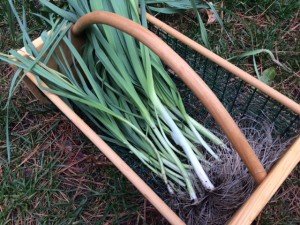
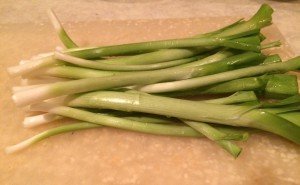 I decided to add some kick to the background canvas and finely chopped 4 roasted red serranos from my freezer and fresh oregano.
I decided to add some kick to the background canvas and finely chopped 4 roasted red serranos from my freezer and fresh oregano.
 On it's own, this soup is mild but hearty making it a perfect backdrop for any number of flavor profiles.
On it's own, this soup is mild but hearty making it a perfect backdrop for any number of flavor profiles. The genius of this soup is the mandolin sliced potatoes.
The genius of this soup is the mandolin sliced potatoes.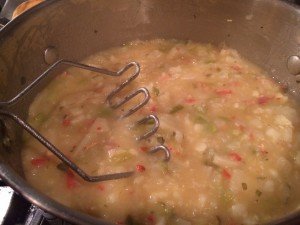 Once cooked through and gently mashed, they thicken the stock and the mashing breaks the potatoes into bite-sized pieces.
Once cooked through and gently mashed, they thicken the stock and the mashing breaks the potatoes into bite-sized pieces.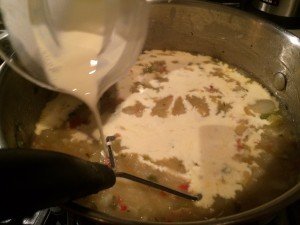 Add a little cream and cook on low for a few more minutes and voila!
Add a little cream and cook on low for a few more minutes and voila!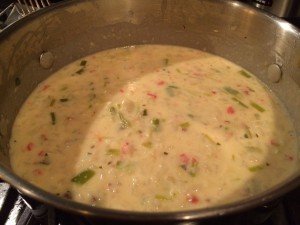 A delicious meal that varies depending on preferences and additions!
A delicious meal that varies depending on preferences and additions!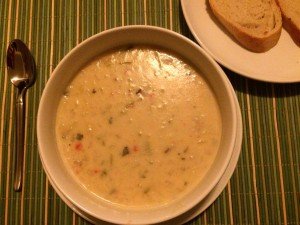
Growing Sustainability - Part 1
 I have three 24 x 36 cork boards in my home office, devoted to helping me organize my garden. They are filled with seasonal planting guides for Zone 7, my own garden plans for seasonal and succession plantings, companion planting charts and the listings of vegetables by family that make sense of them.Interspersed between these work-a-day printouts are some of my favorite images of the WWI National War Garden Commission (1910-1920) and WWII Victory Garden (1930-1950) posters. I have long been a fan of these nostalgic images for what they represented at the time and what they represent to me* today.The images, although quaint and nostalgic now, when they were produced were part of a bold initiative that is difficult to imagine ever repeating itself in the light of 21st century politics. The world leaders at that time asked of their people to be a little more self-sufficient for a while, to do a little more for themselves and consume less, not for any immediate personal benefit for those making the sacrifices of growing and preserving their own food, but for "the greater good". They also represent a generally accepted, society endorsed back to the land movement long before the Foxfire books of the 1970s solidified in the public mind that unless you are a farmer by trade, growing a significant portion of your own food is a hallmark of an alternative lifestyle.With the War Gardens of WWI and later the Victory Gardens of WWII, ordinary households economized during rationing. They grew, ate, canned and preserved some of their own produce to nourish their families and to help the war efforts by using less of the nation's production and transportation resources so those resources would be available elsewhere.It was a time of lofty and aspirational ideals and pulling together for a purpose larger than ourselves. Some of the growing ideas and solutions promulgated during that period, particularly of WWII were a mix of good and pretty bad, but the overall concept was a good one - a decentralized food system, self-sufficient citizens and a government system that supported the bootstraps mentality that has become a hallmark of those generations.
I have three 24 x 36 cork boards in my home office, devoted to helping me organize my garden. They are filled with seasonal planting guides for Zone 7, my own garden plans for seasonal and succession plantings, companion planting charts and the listings of vegetables by family that make sense of them.Interspersed between these work-a-day printouts are some of my favorite images of the WWI National War Garden Commission (1910-1920) and WWII Victory Garden (1930-1950) posters. I have long been a fan of these nostalgic images for what they represented at the time and what they represent to me* today.The images, although quaint and nostalgic now, when they were produced were part of a bold initiative that is difficult to imagine ever repeating itself in the light of 21st century politics. The world leaders at that time asked of their people to be a little more self-sufficient for a while, to do a little more for themselves and consume less, not for any immediate personal benefit for those making the sacrifices of growing and preserving their own food, but for "the greater good". They also represent a generally accepted, society endorsed back to the land movement long before the Foxfire books of the 1970s solidified in the public mind that unless you are a farmer by trade, growing a significant portion of your own food is a hallmark of an alternative lifestyle.With the War Gardens of WWI and later the Victory Gardens of WWII, ordinary households economized during rationing. They grew, ate, canned and preserved some of their own produce to nourish their families and to help the war efforts by using less of the nation's production and transportation resources so those resources would be available elsewhere.It was a time of lofty and aspirational ideals and pulling together for a purpose larger than ourselves. Some of the growing ideas and solutions promulgated during that period, particularly of WWII were a mix of good and pretty bad, but the overall concept was a good one - a decentralized food system, self-sufficient citizens and a government system that supported the bootstraps mentality that has become a hallmark of those generations.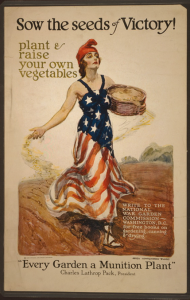 *Results may vary
*Results may vary
Seeding the Future
One of my goals for my 2015 garden is to save more seed. Previously I had saved only cilantro/coriander and some flower seeds, but I am turning a corner in 2015 and saving as many seeds from the varieties I grow as possible. The corner of my home office has become the space for drying seeds to be saved for next year's planting.Some of the seeds I am saving are edible as seed, like the Titan Sunflowers I am growing this year in honor of my years in Kansas. These (and the other Titans) will be split between seeds for planting and snacks.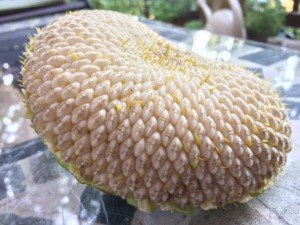 But most are seeds for planting's sake, saving the best and brightest from this year to plan(t) for next year.
But most are seeds for planting's sake, saving the best and brightest from this year to plan(t) for next year.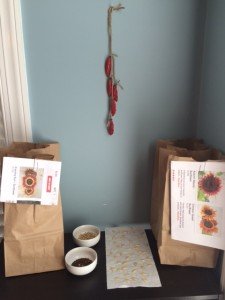 Right now I have some serrano peppers, 3 varieties of sunflowers, spaghetti squash, balsams and candy tufts seeds drying. I will be adding golden acorn squash and oregano to my corner soon.By saving seed from the plants that did best this year, I am selecting those that are most likely to do best in my specific micro-climate again next year, preserving genetic diversity (always a good idea), saving a bit of money in my garden plan for next year and creating a greater level of sustainability for my little acreage and those that want to share in the surplus of seeds.Not a bad way to start the weekend :)
Right now I have some serrano peppers, 3 varieties of sunflowers, spaghetti squash, balsams and candy tufts seeds drying. I will be adding golden acorn squash and oregano to my corner soon.By saving seed from the plants that did best this year, I am selecting those that are most likely to do best in my specific micro-climate again next year, preserving genetic diversity (always a good idea), saving a bit of money in my garden plan for next year and creating a greater level of sustainability for my little acreage and those that want to share in the surplus of seeds.Not a bad way to start the weekend :)
Making Hay While The Sun Shines - Part 3
The wonderful thing about being taken under the wing of a traditional southern food mentor is that in addition to the lesson at hand, there are other tantalizing tidbits sprinkled throughout the lessons like breadcrumbs, just waiting for me to pick up the trail.During my green bean pressure canning lesson, the utensil drawer was opened to look for some other object and the Norpro Wood Corn Cutter and Creamer made its debut into my life. My mentor explained that device is used to cream corn, which she does annually with Silver Queen, her favorite hybrid variety. The tool was dropped back into the drawer and the green bean lesson continued.That night I began researching the tool and process of making and preserving creamed corn. My mentor uses the "Another way" method described at the bottom of this link over at the National Center for Home Food Preservation (the online bible for how to safely preserve food). The creamer tool was so inexpensive and the corn so abundant at the NC State Farmers Market, I had to give it a try!My whopping 45.5 lbs of corn had 65 ears in it and sold for only $25 - one of the many great reasons to grow or buy abundantly in season and preserve in wholesome ways for the off season. I enlisted help from the cutest and most enthusiastic corn shucker imaginable to get through the pile.
I enlisted help from the cutest and most enthusiastic corn shucker imaginable to get through the pile.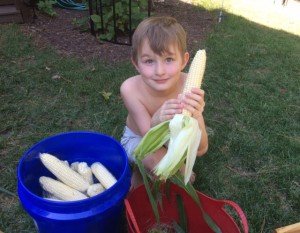 Once shucked, the corn was washed, trimmed of any ear worm damage and ready to be creamed. It took a little experimentation to get the cutters to the right height for the chunkiness I desired. I found compromise by setting it on a creamier height and using knife cut corn once every 8 or so ears to get nice big kernels.
Once shucked, the corn was washed, trimmed of any ear worm damage and ready to be creamed. It took a little experimentation to get the cutters to the right height for the chunkiness I desired. I found compromise by setting it on a creamier height and using knife cut corn once every 8 or so ears to get nice big kernels. Following the instructions from my mentor and the National Center for Home Food Preservation the creamed corn was cooked in two double boilers for about 10 minutes.
Following the instructions from my mentor and the National Center for Home Food Preservation the creamed corn was cooked in two double boilers for about 10 minutes.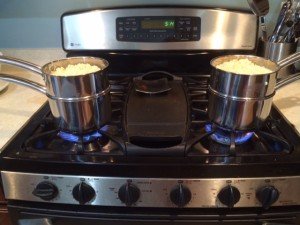 Once thickened it the pots were set in an ice bath to stop the cooking process.
Once thickened it the pots were set in an ice bath to stop the cooking process. Once cooled, it was ladled into the freezer bags that work with my vacuumsealer at serving sizes of roughly 15.5oz each. They were frozen flat to take up less space then vacuumsealed.
Once cooled, it was ladled into the freezer bags that work with my vacuumsealer at serving sizes of roughly 15.5oz each. They were frozen flat to take up less space then vacuumsealed. All in all, my 45.5lbs of corn ended up being 15.5lbs of creamed corn with much of the difference being the cobs that were cut up and added to compost so they were a gain for next year's soil also. The entire process took about 4 hours from shucking to the last batch being put in the freezer and finished with a total of 16 servings. I froze 15 of them for the months to come and made one fresh that night. I knew the project was a success (and one likely to be repeated before the end of corn season) when my little shucker took his first bite of our homemade creamed corn and asked if there was enough for seconds.
All in all, my 45.5lbs of corn ended up being 15.5lbs of creamed corn with much of the difference being the cobs that were cut up and added to compost so they were a gain for next year's soil also. The entire process took about 4 hours from shucking to the last batch being put in the freezer and finished with a total of 16 servings. I froze 15 of them for the months to come and made one fresh that night. I knew the project was a success (and one likely to be repeated before the end of corn season) when my little shucker took his first bite of our homemade creamed corn and asked if there was enough for seconds.


